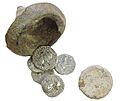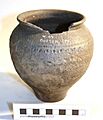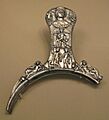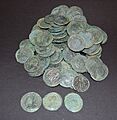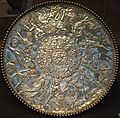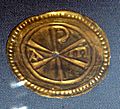List of Roman hoards in Great Britain facts for kids
The list of Roman hoards in Britain tells us about amazing ancient treasures found in Great Britain (that's England, Scotland, and Wales). These treasures are collections of coins, jewelry, metal objects, and other valuable items from the time when the Roman Empire controlled Southern Britain, from AD 43 until about 410. Some hoards were even buried a bit later, as Roman rule ended and new kingdoms began.
These hoards include things people buried to keep safe, like their personal savings, a merchant's goods, or even stolen loot. They also include special items offered to gods, which were never meant to be dug up again. However, this list doesn't include items buried with people in graves or single items found alone.
Most Roman hoards are made mostly or entirely of coins. Over 1,200 of these coin hoards have been found in Britain! Some hoards, like the famous Mildenhall Treasure and the Hoxne Hoard, also contain beautiful silver or gold items like dishes, bowls, jugs, and spoons, or sparkling jewelry.
What are Roman Hoards?
Roman hoards are like ancient time capsules. They are collections of valuable items that people buried in the ground long ago. Imagine hiding your most precious belongings to keep them safe! These hidden treasures give us clues about daily life, beliefs, and even dangers in Roman Britain.
Why Did People Bury Them?
People buried hoards for many reasons:
- Keeping things safe: If there was danger, like an invasion or a battle, people would quickly bury their valuables to protect them. They hoped to come back later and dig them up, but sometimes they couldn't.
- Saving money: Just like today, people saved their coins. Burying them was a way to keep them secure, especially if there were no banks.
- Offering to gods: Some hoards were not meant to be found again. These were special gifts, called votive offerings, given to gods or spirits. They might be placed in sacred places like springs or temples.
- Hiding stolen goods: Sometimes, hoards were buried by thieves trying to hide their loot.
What's Inside a Hoard?
Hoards can contain many different things:
- Coins: These are the most common items. Roman coins can tell us about the emperors who ruled and the economy of the time.
- Jewelry: Rings, bracelets, necklaces, and brooches made of gold, silver, or bronze are often found.
- Tableware: Fancy dishes, bowls, and spoons, especially those made of silver or pewter, show us how wealthy Romans lived.
- Tools and other objects: Sometimes, hoards include tools, weapons, or other everyday items.
Famous Roman Hoards in Britain
Many incredible hoards have been discovered across Britain. Each one tells a unique story about the people who buried it. Here are a few well-known examples:
The Hoxne Hoard: A Farmer's Discovery
The Hoxne Hoard is the largest collection of late Roman gold and silver found in Britain. It was discovered in 1992 by a farmer in Hoxne, Suffolk, who had lost a hammer!
- When it was buried: Around AD 408, just as Roman rule in Britain was ending.
- What was found: It contained an astonishing 14,865 coins (mostly silver and gold), 29 pieces of gold jewelry, 98 silver spoons and ladles, four silver bowls, and other silver items like a tigress figurine and pepper pots.
- Why it's special: The hoard was carefully packed in a wooden chest. It gives us a fantastic look at the wealth and luxury of a rich Roman family living in Britain during its final years under Roman rule.
The Mildenhall Treasure: A Grand Feast Set
The Mildenhall Treasure is another spectacular find. It was discovered in 1942 in Mildenhall, Suffolk, by a farmer plowing his field.
- When it was buried: Around the mid-4th century AD.
- What was found: This hoard consists of 34 beautiful silver items, including large dishes, bowls, and platters. The most famous piece is the "Great Dish," which is huge and decorated with amazing scenes from Roman mythology.
- Why it's special: These items were probably used for grand feasts and show the high quality of Roman craftsmanship. It's thought they belonged to a very wealthy Roman family.
The Corbridge Hoard: A Soldier's Kit
The Corbridge Hoard (found in 1964) is different from the others because it's not mostly coins or fancy tableware. It was found at the Roman fort of Corbridge in Northumberland.
- When it was buried: Mid-2nd century AD.
- What was found: This hoard contained a collection of iron objects, including pieces of armor, a sword scabbard, javelinheads, spearheads, arrowheads, and various tools like knives and nails.
- Why it's special: It seems to be a Roman soldier's toolkit or a collection of items from a military workshop. It gives us a rare glimpse into the equipment and daily life of the Roman army in Britain.
The Ribchester Hoard: A Cavalry Helmet
The Ribchester Hoard was found in 1796 near the Roman fort of Ribchester in Lancashire.
- When it was buried: Late 1st to early 2nd century AD.
- What was found: The most famous item is a stunning bronze cavalry helmet with a face mask. It also included bronze bowls, pieces of a vase, a bust of the goddess Minerva, and other fragments.
- Why it's special: The helmet is incredibly detailed and was likely used for parades or ceremonial events, not just battle. It shows the impressive artistry of Roman military equipment.
The Inchtuthil Hoard: A Mountain of Nails
The Inchtuthil Hoard is unique because it's not about gold or silver, but iron! It was found at the Roman legionary fortress of Inchtuthil in Perth and Kinross, Scotland.
- When it was buried: Late 1st century AD.
- What was found: An incredible 875,400 iron nails! They were buried in a pit.
- Why it's special: The Romans were leaving Scotland, and they didn't want the local tribes to get their hands on valuable iron. So, they buried this massive supply of nails before they left. It's a huge example of Roman planning and resource management.
Images for kids
See also


